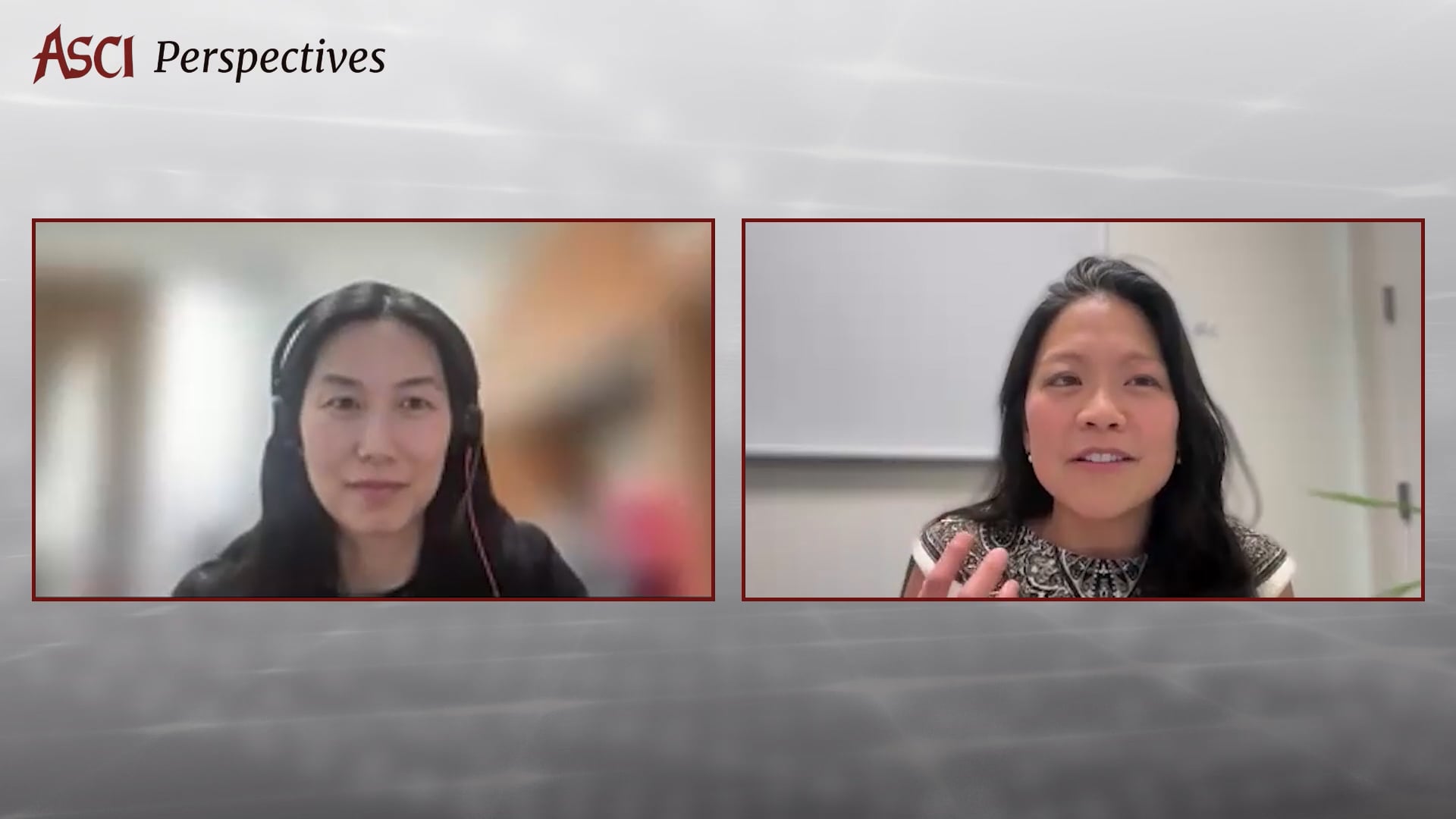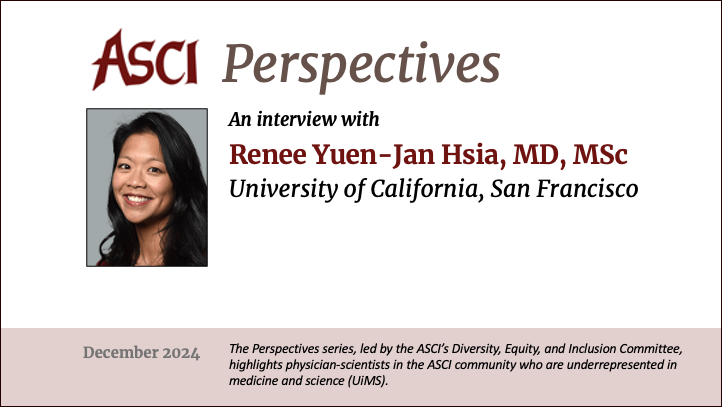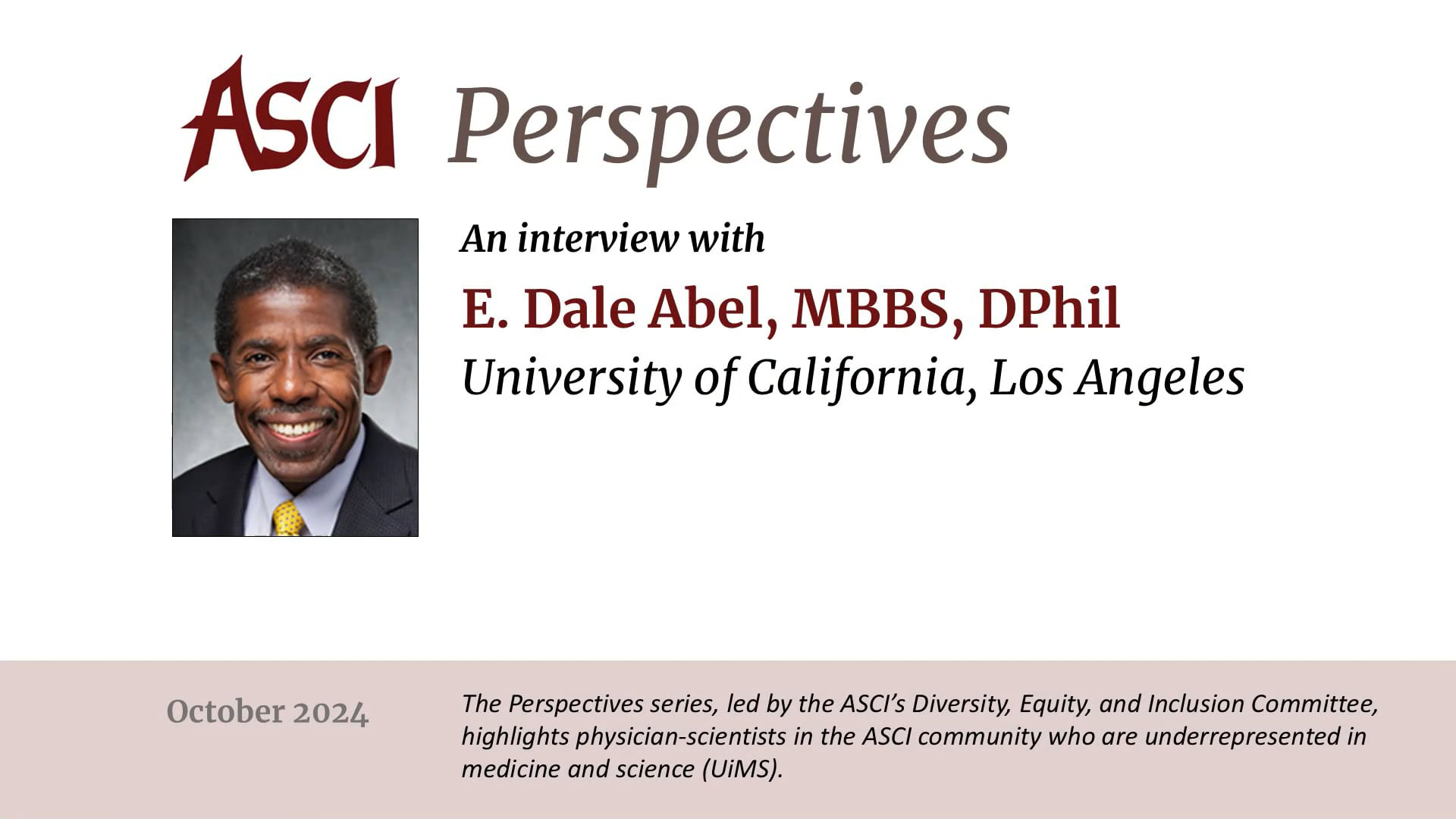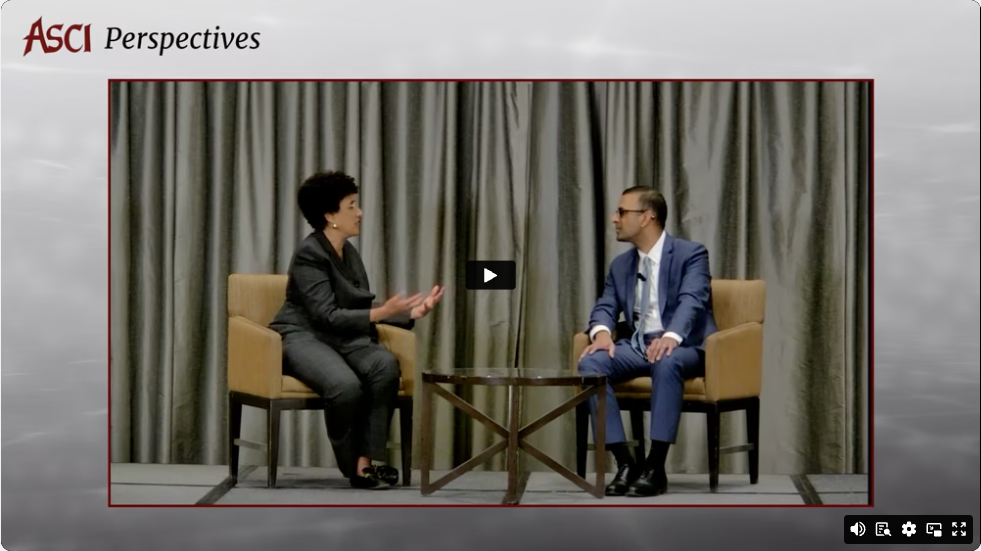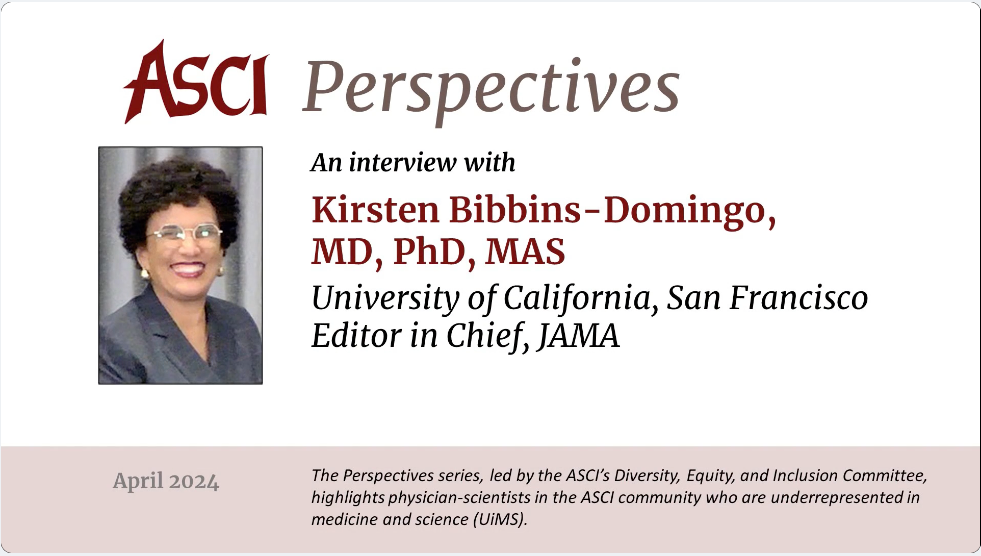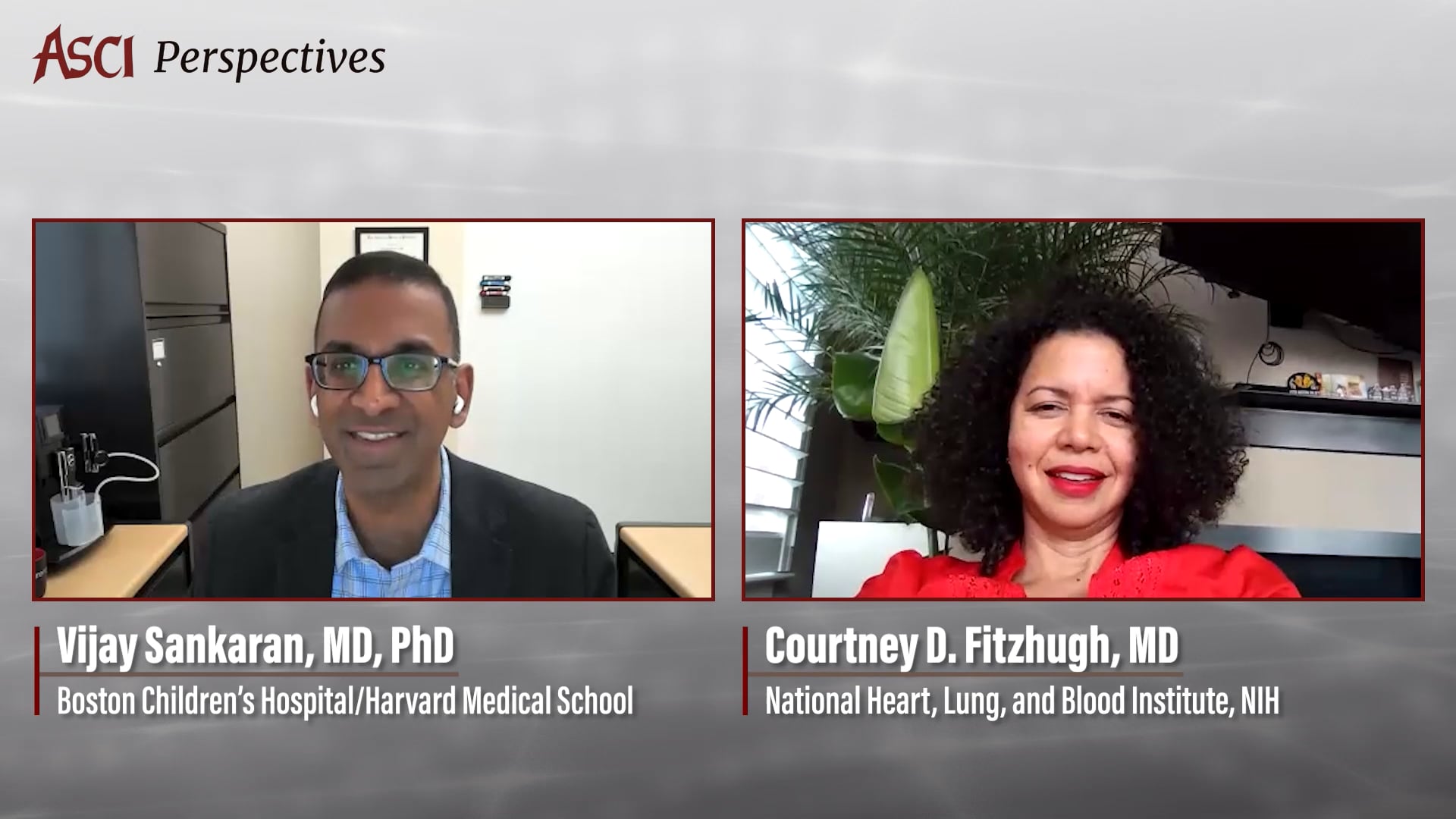Interview with E. Dale Abel, MBBS, DPhil, UCLA (elected 2004), August 20, 2024, at UCLA.
Interviewed by Utibe R. Essien, MD, MPH; UCLA, Consulting member, ASCI Physician-Scientist Engagement Committee (2023 Young Physician-Scientist Award recipient).
Note: The text represents the unedited interview recorded by the UCLA Department of Medicine Communications team. It has been edited for readability by ASCI staff.
Dr. Utibe Essien: Welcome to the ASCI Perspectives interviews. I ’m Utibe Essien at the David Geffen School of Medicine at UCLA, and I ’m thrilled to have the honor of interviewing today Dr. Dale Abel. Dr. Abel is the William S. Adams Distinguished Professor and Chair of the Department of Medicine at the David Geffen School of Medicine at UCLA and Executive Medical Director at UCLA Health. Dr. Abel has had a distinguished career in endocrine and metabolism research. His pioneering work on glucose transport and mitochondrial metabolism in the heart guides his current research interest, including molecular mechanisms responsible for cardiovascular complications of diabetes. Dr. Abel ’s research program has been continuously funded since by the National Institutes of Health, the American Heart Association, and the American Diabetes Association, amongst others. Dr. Abel ’s distinguished career has resulted in numerous recognitions, including election into the American Association of Physicians, the American Society for Clinical Investigation, the American Clinical and Climatological Association, the National Academy of Medicine, and the National Academy of Sciences. Dr. Abel is the past president of the Endocrine Society and this past year was recognized with one of its most distinguished awards, the Fred Conrad Koch Lifetime Achievement Award.
And so, Dr. Abel, thank you so much for meeting with me today.
Dr. E. Dale Abel: It ’s a real pleasure to be with you this morning.
URE: So we are going to have a conversation today, and we ’re going to start with maybe asking you about your journey. Love to know how you came to this career of science and medicine. What brought you to where we are today?
EDA: That s a really good question. So, many know, but not everybody knows: I was born in Jamaica, in the year that the country became independent. So I grew up in, I would say, immediate postcolonial Jamaica. My parents were elementary school teachers. My grandparents were subsistence farmers. Between the two parents, there were about 19 children, between them. So, a big family. And, you know, one of the things that I heard growing up from a pretty young age, and this is pretty typical of the time, was you had to become a doctor, a lawyer, or an engineer. That was pretty much soaked into your head from the time you heard your parents talking to you. But it wasn ’t in a pushy away. It was just that there was this belief that education was really the way forward. So I always kind of figured I was going to become a doctor, because it was either that or a lawyer or engineering. I knew I didn ’t want to become a lawyer. And the engineering part, you know, I wasn ’t so sure about. So what that therefore meant was that, you know, going through high school, you took the courses and the classes that would get you sort of primed to enter medical school. So there ’s no point in my life that I didn ’t think that I was going do anything besides medicine. So I went to the University of the West Indies, which was the medical school there, formerly one of the external colleges of the University of London. And the training at the time was very kind of traditional British-model training, just bedside teaching, very clinical. You learned medicine one patient at a time, right? And so having gone through medical school, I felt pretty comfortable with being a good clinician. But there is this little itch, which I had to scratch, which was: How did all of this knowledge get into the textbooks? Right? I had some professors who were clearly very knowledgeable. One of the reasons, for example, why I think I gravitated towards diabetes and metabolism research is that the professor medicine, at the time when I was the equivalent of a sub-I, would come and just regale us with all this knowledge about metabolism and diabetes. And I was saying, “How did you know that? How did Krebs know that the cycle went that way and not that way?” Right? And you had liver slices at the time: how did that get discovered? So I had this kind of sense of dissatisfaction that: Yeah, I felt I was a good doctor; I felt I could diagnose almost anything that came in front of me. But I wasn ’t so sure how this knowledge got into the textbooks. And so that was a curiosity which drove me towards seeking out a career in science.
The reality was, at the time in the West Indies that there really were not significant resources to train in science in the deepest possible way. So I figured I ’d probably have to leave to get that training. And the opportunity came up as I was finishing medical school that I should apply for a Rhodes Scholarship, which then would ’ve allowed to go to Oxford to do my PhD — or for those from Oxford watching, it ’s actually a DPhil, right? So that was the rationale. And so when I was fortunate enough to get this scholarship, then it opened up the opportunity to go to Oxford to get this advanced training degree. I had fairly little concept of what research was. I ’d never held a pipette. And back in those days, that was of course in the pre-email era when I had to actually write a physical letter — novel concept these days — but write a physical letter to the person who was going be my default supervisor and said, “Okay, I ’m a Rhodes Scholar, and I want to work with you for my PhD.” So that was really the entrée into research. And also really interesting was that because — he was really a clinical researcher, and his area was hypertension. His name is John Ledingham. He recently passed away. But there ’s the English version of Harrison ’s called the Oxford Textbook of Medicine. If you go back, you see his name as one of the editors of the Oxford Textbook of Medicine. And so he said, “Look, I studied hypertension, but there ’s this thing” — of course, remember this is like last century now — “so there ’s this thing called the metabolic syndrome that seems to cluster with high blood pressure. And we have some colleagues who are studying how to measure glucose disposal from intravenous glucose tolerance data. And we think that there might be a connection between the two. Why don ’t you come and study that?” And I said, “Okay, that sounds good to me.” Right? And so that was really my entrée into metabolism research. Which really was — I started off doing clinical investigation. And, you know, what then happened was, having gone there and done this, it was pretty clear that I knew I was now really going into endocrinology as a field.
Along the way my parents immigrated to the US. So under the current, or the former — who knows what ’s happening with immigration now — but then, if you were under 21, you got the green card with your family. So I guess that ’s like chain migration, right? So I got my green card, and I figured, well, maybe that would be a good opportunity to actually finish my clinical and train beyond that, you know, in the US. So, a funny story is: My mentor in Oxford, John Ledingham, knew I ultimately wanted to go back to the States to finish my clinical training. But I was a bit nervous because I had my medical degree. and I came to do a PhD, but I have not done doctoring yet. So I was worried I ’d lose those skills. So he marched me up to the office of the Chair of Medicine, Oxford, who was Professor Sir David Weatherall, who had spent some time at Hopkins. And he said, “Here ’s Dale. He wants to come out to America. You have lots of contacts.” So he got on the phone. And he called a bunch of his friends in the States and said, “Look, I have this guy who ’s doing okay in Oxford, but he really wants to come out to America. What can you do?” And one of the people he reached out to was Lew Landsberg. So Lew at the time was the Chair of, or the Chief of Endocrinology at Beth Israel. And so Lew offered me a postdoc. And I said, “Respectfully, I don ’t really want to postdoc. I want to go do a residency.” Long story short: I ended up at Northwestern for residency. As an intern — well, Lew got recruited when I was a first-year resident. So I was a second-year, in the second-year program. He remembered that conversation. And he says, “Well, what do you want to do?” I said, “I want to do endocrinology.” He says, “Well, that ’s nice.” He said, “You have to go to Boston to do that, because that ’s the happening place for, you know, metabolism research.” So everything kind of came full circle. So after I finished my internal medicine residence in Chicago at Northwestern, I actually went back to his former Division of Endocrinology at the Beth Israel to do further training.
And that is where I — having done human physiology as for my PhD work — it was clear that we are entering this kind of the molecular-biology era. And what the Boston group was very strong at was using gene-targeting and transgenic approaches to study metabolism in mice. And so I decided I wanted to go there because I want, I need to learn to knock out genes and manipulate genes and study metabolism. So that ’s kind of how I ultimately ended up in the broad area of metabolic research: so coming from Jamaica, starting off with human studies, and then after residency, really moving into how to model some of these diseases, using at the time contemporary genetic engineering tools in mice.
URE: That ’s awesome. I love that that journey that you shared and the arc of that journey. And I think like many journeys, they have particular people that make differences, whether it ’s your parents as teachers, John Ledingham you mentioned as your mentor. Maybe you can share with us a little bit about what these mentors have meant to your career — and even sponsors, like you mentioned.
EDA: Yeah, that ’s a very good question. So, I feel really incredibly blessed to have had a number of people who were just incredibly generous in terms of mentorship and guidance. So John Ledingham is one of them that I mentioned. And even before that, you know, there were professors at the medical school who clearly recognized that the curiosity that you had really had to be ultimately addressed. When I then, of course, you know, came over here to the US, I would say that, Lew Landsberg was also a very strong and consistent mentor. He clearly pointed me in the direction to go to Boston to train in metabolism. And I ended up working in the laboratory of Barbara Kahn. So Barbara studied glucose transport. She was one of the first people to really study the physiology of a particular glucose transporter called GLUT4, which was enriched in adipose tissue. And my project was to use gene targeting to actually knock out GLUT4 from fat. Now, it sounds that routine now, because when I talk to my trainees, they can just like, you know, order a knockout mouse online, right? But back in those days, you had to make it. It ’s like making pasta from scratch, like going to the field and finding the wheat and grinding the flour and making the pasta. I mean, that is kind of how you made a knockout mouse back in the day. Right? So that was my project. Now, the only reason why in retrospect — I wouldn ’t necessarily give somebody that advice now that I probably . . . and maybe it was some naiveté as well on my part: I had no idea how involved and complicated this was going to be. But what gave me a long enough runway, and I think you could identify with this, was: Before I went up to Boston, Barbara Kahn said to me, “Hey, there ’s this grant from this group called — at the time, it ’s called the Robert Wood Johnson Minority Medical Faculty Development Foundation. Now it ’s called the Harold Amos Foundation. Because Harold Amos, as you know, is a former biochemistry professor at Harvard, was the person who really pioneered this. And said, “Look, this is really designed to support promising individuals who are historically underrepresented in medicine and science. But we need to come up with a project.” So we were going back and forth. I was like a third-year resident at Northwestern. And so we ’re going back and forth in this. So anyway, I submitted this thing, and, long story short, I got it, right? So by the time I was a second-year fellow, I had like four years worth of support. So that means that I could actually take on a sort of a more high-risk project. The unique thing about this, as you know — because I believe you are also an Amos Fellow as well —
URE: Yeah, that ’s right.
EDA: Right. Is that it ’s not just simply a grant that you get: you get a grant and you also get an advisory committee of some amazing senior people in academic medicine. And so my assigned RWJ advisor was Jim Gavin. I think we know Jim well. And, you know, Jim has had an in illustrious career in academia, I believe at Emory and then also WashU. And then he went to Howard Hughes. And so I could call him up and I could actually get advice from him about navigating whether it ’s, you know, academic politics in Boston or elsewhere. Right? And that was just incredibly valuable. And, you know, if you look now at sort of just the track record of that organization, I mean the alums of this program are major leaders in academia, as you know very well. So I felt, you know, very, very fortunate to have access to that level of mentorship and support as well.
And I can give you one more example. So I was in Boston for a total of eight years and then got recruited to the University of Utah. I remember calling my assistant and saying, “I ’m going to Salt Lake,” and hearing the silence on the other end of the phone, like, “You ’re going where? Salt Lake City?” I said, “Sure.” But the reason I went there was that there ’s another mentor, his name is Guy Zimmerman, who oversaw a program there that was focused specifically on physician-scientists. And the idea was, we ’d get people to come to an environment that actually spawned a Nobel Prize actually, subsequently, and just give you five years of just complete protection. And we want you to be creative scientifically. You can have, you ’re going to be in a neighborhood of people who are just really smart. And those are going to be your peers. And just is incredibly attractive. I had never been to Utah before but end up spending 13 years there. And you know, and looking back now, if you look at people who went through, quite a few are in the National Academy of Sciences. One person is like the president of Merck. And so: very, very accomplished individuals. And again, but Guy was really a very steady mentor, who essentially — in fact, it was Guy who actually nominated me for membership in the ASCI. Right? And so he really knew how to open those doors to actually get you connected where you needed to be connected. Because he knew it wasn ’t just getting grants and publishing good papers. You had to know people. And so, you know, he was very good at making those critical introductions or the critical nominations. And so I would also view him as really a very important mentor as well.
URE: No, that ’s great. That ’s great. And I think you just mentioned, a lot of us listeners on the Perspectives are early in our physician-training careers. And I think we ’re putting our head down, writing grants and getting papers, which — I know we ’ve talked about — that ’s so critical for the early stages. What are some of those other, I guess, intangibles that you think are so critical for us in our early stage of training, whether it ’s the relationships we develop with these mentors, seeking other opportunities? Sure. So, you know, I think one of the things that I would say, and I can say it now because I ’m getting old, and I can — you can look back at life and see all these things which you did and you can spin it to make it sound like you ’re really smart in making decisions along the way. But one of the things which I think happens to all of us, especially early in our career, is we all have a little bit of imposter syndrome, which is like, “Are we really good enough? Do people really believe that this is our idea or our work?” I mean, I remember vividly, you know, at at a Keystone conference standing beside a poster, which — I would at the time I was young, but that was my, my life ’s work, right? Standing there, and somebody comes up, and the first thing that they said, they looked straight at the last author ’s name and said, “So that ’s what they ’re working on in that person ’s lab.” And I ’m like, “It ’s my work. It ’s my project.” Right? But I don ’t think they were being mean or anything, but I think the reality is that there ’s this tendency for it to take a little time for people to actually learn and recognize what your independent contributions are. And so, one thing I would say, to my early-career colleagues who might be watching this video is: Be patient and recognize that sometimes the field might be a little bit slow to recognize what your contributions are. And they will come around to it. And once they come around to it, then it starts to accelerate. Right? Sometimes people are a little impatient. They can take a little bit push and say, “That ’s mine. I did that.” And people are going to say, “Why are you forcing this on us?” And so I would say that it ’s important to kind of take the long view, that it ’ll take a while to build up your reputation in the field, to build up your “portfolio,” as it were. But consistency in that theme will eventually — not always, unfortunately — but eventually will be recognized.
URE: Yeah. Consistency. I think that ’s a key through line in our conversation today as well. What are, speaking of fields, what are you excited about in terms of the new openings, new awakenings in your fields in particular?
EDA: Sure. So I ’m an endocrinologist by training. And, you know, every subspecialist thinks that their particular organ is like the center of the universe.
URE: Naturally.
EDA: Of course, endocrinology: We have multiple organs, right? We have all these glands everywhere. And even organs that people wouldn ’t think are endocrine organs are endocrine organs. So like the heart is an endocrine organ, it actually secretes hormones, right? The skin is an endocrine organ, an endocrine organ. Muscle is an endocrine organ. So, the unique kind of path that my career took was that — So as you recall, I told you we were studying glucose transport in fat. So because we were making tools to eliminate genes in specific cell populations, it turns out that there is a lot of GLUT4 in the heart. So we had the tools to essentially knock out GLUT4 in cardiac muscle cells. And funnily, that project actually finished a little earlier than the fat cell project. But when you knock a GLUT4 in the heart, you get cardiac hypertrophy. And I got thinking that, “Hmm, what happens to glucose metabolism in the heart? Or are there conditions where glucose metabolism is perturbed in heart?” And in terms of that, in diabetes GLUT4 levels go down, glucose levels are reduced. And of course, diabetes, particularly type 2 diabetes, is actually associated with cardiac hypertrophy. So that was a threat, right? That got me kind of thinking about the interaction between metabolism and cardiac function; and metabolism and heart failure; and metabolism and heart failure in diabetes. Now, so I began to work in this area, and I began to actually realize that the people who were in this field weren ’t necessarily endocrinologists. They were cardiovascular researchers. And so I began going to heart meetings, and people were wondering if I was a cardiologist, which I am not. I ’m a card-carrying endocrinologist. But what that essentially did was over many years made us recognize that because sometimes science tends to be somewhat siloed, that the individuals in cardiovascular research were thinking about this a certain way, which is probably a little bit different from what somebody say with an endocrine background would be thinking about this.
And so for many years I talked about something called diabetic cardiomyopathy, which is heart failure risk in diabetes. And my . . . at the time, my cardiology colleagues were saying, “That doesn ’t happen. Diabetes doesn ’t cause heart failure,” which is technically sort of true. It doesn ’t primarily cause it, but what it does is that it sensitizes the heart to fail more rapidly in the presence of other stressors. Fast-forward now to 2024. And you have all these diabetes medicines now are treating heart failure. Right? There ’s SGLT2 inhibitors, GLP1 receptor agonists. And for example, you know, cardiometabolic syndrome is no longer, you know . . . and all of a sudden the heart is now a victim of the abnormal metabolism that occurs in obesity and diabetes. And in fact is now being called cardiometabolic-renal. Right? Because the kidneys are also involved. So in one sense, sitting back as an endocrinologist saying, “Well, this is endocrinology. This is organs talking to each other.” Right? And so to your question in terms of what is in my area of interest really exciting is this kind of concept of inter-organ communication in metabolic homeostasis. And so that something that goes wrong in adipose tissue can send signals that impact what may happen in the heart. And the heart in turn may send a signal to the brain that in turn regulates metabolism in the liver that then feeds back to make your glucose go higher. And so, you know, the concept of really trying to identify these novel inter-organ communication pathways that can drive cardiometabolic disease is something that we are very interested in and continue to be focused on.
URE: I love that. We ’ve got decades more work down the pipeline, I think, is what I ’m hearing.
EDA: For the field.
URE: “Maybe not for me.” I have just two more questions. I think as we wrap up. I ’m really interested, and I think our listeners will be, around transition points. I think that is so challenging for early-career folks to look out and see themselves in new places and spaces that they may not have been, whether it ’s a new field like you just alluded to, or a new city, a new country in your case. What are some kind of lessons learned in those moments of transition? I think that can be really challenging for a lot of folks early in their career.
EDA: No, I agree. I think, well, transitions are times of significant uncertainty and can also be times that are very lonely, because sometimes you may feel that you are making this transition alone. And this is where I think it is very important to have very various layers of support. And by support, I ’m not only just referring to mentorship that can mentor you through the transition — So sort of vertical mentorship, people who are more experienced than you. But but also peer mentorship: others who are making similar transitions, whether in your geographical location or somewhere else, that you can talk with and interact with. And so, for example, you know, the community of Harold Amos Scholars, for example, was one peer group that I kept plugged into as I was kind of navigating these transitions. But there certainly have been others. Many, for example, who are colleagues that I ’ve come to know and appreciate, you know, within the Endocrine Society. Importantly, I have a personal commitment to kind of paying that forward.
What you may or may not know is that for the last, what, 15 years, I ’ve led a program within the Endocrine Society called the FLARE [Future Leaders Advancing Research in Endocrinology] program, which is a career-development program that targets individuals who are historically are underrepresented in science and medicine. And it ’s been funded now for three cycles by the NIDDK. But what we have done is that we have taken the approach that the highest-risk points for individuals in advancing in a career that could be looked at subsequently as being a successful biomedical research career is at these transition points — whether it ’s the transition point from, you know, graduate school to postdoc or postdoc to early career or early career to tenure that if you look at what happens, that is where people tend to fall off or have the greatest difficulty. And so we have focused the program around really identifying and mentoring individuals who we recruit and select because they are close to one of these transition points. And what we basically do is that we give them training in many of the soft skills, like negotiation, selling your science, communicating your science, understanding that not everybody in the world has your personality. And that it ’s important to understand what your personality is, because it might explain why you can ’t get along with somebody across the hall who may be looking at the same facts as you and having a very different reaction to it. But that person can ultimately be your ally if you kind of understand those dynamics. So we take our trainees through a pretty intensive residential program and then we insert them into internship opportunities, largely based within the Endocrine Society. We get among committees, various committees that run the gamut. We hook them up with mentors. And as I ’ve looked back over the past 15 years, the trajectory has just been absolutely incredible. That individuals who we have watched come through at various career stages, many of them now are tenured. Many of them . . . a couple of them, I think, you know well personally. I can give a shout to one of my field mentees, Joshua Joseph, who you know very well, who was also an ASCI inductee a couple of years ago. He ’s a part of that program. And so I ’m actually very proud of what we have done in terms of putting in place opportunities for individuals to navigate these transitions. Because I didn ’t have anything like that when I was kind of “growing up.” I did okay in the end. But I think that investing in the future in that much more directed way will have a much greater likelihood of long-term success.
URE: That ’s awesome. It ’s very intentional.
EDA: Exactly.
URE: It ’s not a, kind of, haphazard approach to it.
EDA: Right. Exactly.
URE: Love that. Well, Dr. Joshua Joseph will be a future ASCI in a Perspective interview, so shout out to that. Well, as we close, I know I ’m biased as an early-career person and been looking for pearls for folks in that stage, but maybe general pearls for physician-scientists, leaders, early-career folks, whatever stage we ’re in, in this journey.
EDA: Sure. What I would say to this that, you know, science is fun, but science is tough. Right? We have all have bruises to show, having gone through peer review. We ’ve had our papers rejected, we have had our grants rejected. But what I would say is that despite the toughness of just the importance of scientific rigor, that should not make you mean. You can be tough, but not mean. Right? And so, you know, I would say — a pearl, if you like — is that as you advance in your career, you are going to be interacting with many people. Many of them are going to be your trainees. And people are going to be looking up to you to model what you ’re doing, to kind of gain from your experience. You ’re going to have collaborators. And I would say that in all of those interactions, you want to treat people with openness, transparency, and integrity. Because ultimately, you want to believe that if something goes down, there are people watching your back. And certainly if you really have that attitude as a mentor for your trainees, I can tell you they will watch your back. Right? And similarly, your colleagues and peers will watch your back. And ultimately what you then find is that you have a community of individuals who are more than happy to be your sponsor, to be your nominator, to write you letters, to invite you to their place to give a talk and become friends and colleagues. And so I think that that is an important lesson I ’ve learned throughout my journey. I would definitely encourage anybody who is kind of making their way, is that as tough as it is, you always want to be fair, you always want to be mindful of others. You don ’t want to be, like, getting ahead and sort of pushing people out of the way. You don ’t want to get ahead in a way that you can ’t bring others along.
URE: That ’s awesome. Well, thank you so much again for taking the time to meet with us today. And thank you everyone for listening to this ASCI Perspectives interview. Take care.
EDA: Thank you.
URE: Thank you.


